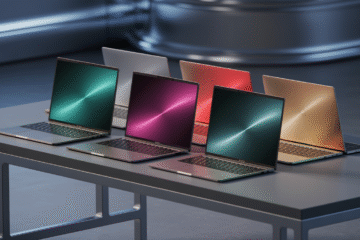Best Student Laptops for College (2025): Smart Picks, Smarter Study
College life in 2025 runs on a laptop—lectures on Zoom, notes in the cloud, citations from AI tools, and group projects that live in shared drives. The best student laptop isn’t just “fast”; it’s the one that stays reliable in week 12 of the semester when you’ve got 40 tabs open, two docs due, and a battery warning blinking in the library. This guide gives you a simple framework to choose confidently and then ranks five accessible models that hit the right balance for campus life.
How to Choose a Student Laptop in 2025
Performance That Feels Fast Every Day
For most majors, smooth performance comes from three pillars:
-
SSD: An NVMe SSD is non-negotiable for quick boot and responsive apps.
-
RAM: 8GB is a bare minimum; 16GB is the comfort zone for research, browsers, and note apps.
-
Modern CPU: Recent-gen Intel/AMD chips (or efficient ARM designs) deliver strong battery with enough headroom for multitasking.
Display & Comfort Matter More Than You Think
You’ll read thousands of words every week. A 1080p (FHD) IPS panel reduces eye strain and makes split-screen work usable. Brightness around 250–300 nits is fine indoors; more helps near windows.
Battery Life & Portability
Aim for 8–12 hours real use. A 14–15.6″ screen is the mainstream sweet spot; ultra-slim 13–14″ models travel best but may cost more for the same performance.
Keyboard, Trackpad, Webcam, Mic
-
Keyboard: Look for comfortable travel and a solid deck. Backlight helps in dim lecture halls.
-
Trackpad: A precise, stable pad saves time and frustration.
-
Webcam/Mics: 720p works, 1080p is nicer; dual mics improve clarity for hybrid classes.
Ports & Upgrades
Two USB-A, one USB-C, and HDMI cover most dorm setups. An SD/microSD slot is handy for media majors. If possible, choose models with accessible RAM/SSD; upgrades are the cheapest way to extend lifespan.
Software & Ecosystem
Windows suits most majors and campus tools. If your college standardizes on certain software (engineering suites, statistical apps), verify compatibility. Keep your system bloat-free for best responsiveness.
Spec Targets for Most Students
-
CPU: Recent Intel Core/AMD equivalent (efficiency first, cores second).
-
RAM: 8GB minimum; 16GB preferred.
-
Storage: 256GB SSD minimum; 512GB recommended if you store media locally.
-
Display: 14–15.6″, 1080p IPS.
-
Battery: Rated all-day; real-world 8+ hours light use.
-
Weight: Under ~1.9 kg (4.2 lb) is comfortable for commuting.
-
Warranty/Support: At least 1 year; accidental damage plans are worth it if you commute daily.
The Top 5 Best Student Laptops for College (2025)
Ranked from value-focused picks to the safest all-rounder. Exact configurations vary by retailer/region, so use the “What to look for” notes when shopping.
5- jumper P1 Laptop
Why it stands out
The jumper P1 is all about entry-level affordability without giving up the essentials. It’s a practical choice if you’re on a strict budget and you mostly live in the browser—Docs, LMS portals, research PDFs, and streaming lectures. You get a slim, simple machine that boots quickly and stays quiet.
Best for
First-year students and general education coursework, note-taking, email, and research with modest multitasking.
What to look for
-
8GB RAM and 256GB SSD for smoother daily use.
-
1080p display (IPS preferred) for readable text.
-
A recent budget CPU for decent battery and lower heat.
Pros
-
Friendly price for tight budgets
-
Lightweight and simple to carry
-
Quick boot and app launches thanks to SSD
Considerations
-
Not designed for heavy creative apps or coding environments that need more RAM
-
Speakers/webcam are functional rather than premium
Bottom line: If you’re cost-conscious and your workload is light to moderate, the P1 gets the basics right without drama.
4- SGIN I3 Laptop
Why it stands out
The SGIN I3 targets that “just a bit more than entry level” zone: still affordable, but with the kind of responsiveness that makes a long library session comfortable. It tends to bundle a clean design with usable I/O and a display that’s easy on the eyes for reading.
Best for
Students who want a budget computer that feels fresher when juggling multiple tabs, PDFs, and a few light desktop apps.
What to look for
-
8–16GB RAM; prefer 16GB if you can stretch.
-
256–512GB SSD for local docs, offline videos, and datasets.
-
1080p IPS for clarity; check brightness specs if you sit near windows.
Pros
-
Solid value with better everyday snappiness than entry-only picks
-
Practical port selection for HDMI displays and older USB-A peripherals
-
Light enough to carry all day
Considerations
-
Build and audio quality focus on function over premium feel
-
Confirm upgrade options (RAM may be fixed on some trims)
Bottom line: A smart step-up choice for students who want smoother multitasking and a friendlier display without leaving the budget category.
3- Lenovo IdeaPad 1 Laptop
Why it stands out
Lenovo’s IdeaPad 1 line has become a budget-class staple for students. The priorities are right: a responsive SSD, a comfortable keyboard (a Lenovo strength), and configurations that deliver dependable battery life. It’s the kind of laptop that simply stays out of your way when deadlines loom.
Best for
General majors—business, humanities, social sciences—who need reliable performance for writing, research, and spreadsheets.
What to look for
-
8–16GB RAM (16GB if you juggle many tabs or run desktop note apps + citation managers).
-
256GB SSD minimum; 512GB if you store media locally.
-
1080p IPS panel for long reading sessions; avoid lower-res screens.
Pros
-
Comfortable typing experience for essays and note-taking
-
Sensible thermals and quiet fans under common workloads
-
Often offers straightforward SSD upgrades down the line
Considerations
-
Base displays can be average; prioritize IPS
-
Speakers are serviceable; use headphones for focus
Bottom line: A safe bet for everyday college tasks, with a keyboard that makes long writing sessions less of a chore.
2- Acer Aspire 3 Laptop
Why it stands out
The Acer Aspire 3 is the classic 15.6″ campus workhorse. It gives you a bigger screen for side-by-side windows, typically a full-size keyboard with a number pad, and configurations that remain efficient and cool for an entire day of classes and study.
Best for
Students who love split-screen workflow (slides + notes, research + draft) and want a familiar 15.6″ layout for productivity.
What to look for
-
16GB RAM if you regularly keep many tabs, citation tools, and cloud drives open.
-
512GB SSD if you manage large files (media, datasets).
-
1080p IPS panel; consider an external monitor at your dorm for a low-cost “dual-screen” setup.
Pros
-
Big display is great for multitasking and spreadsheets
-
Full-size keyboard helps with data-heavy majors and finance courses
-
Good thermal behavior and steady performance for long sessions
Considerations
-
Heavier than ultra-slim 14″ models; not ideal for minimalists
-
Speakers and webcam are fine, not studio-grade
Bottom line: If your study style thrives on space—two windows at once, long spreadsheets, longer essays—the Aspire 3 feels immediately more comfortable.
1- HP 15.6 Inch Laptop
Why it stands out
The HP 15.6-inch Laptop earns the top spot by combining balanced performance, a roomy display, and approachable pricing that fits student realities. It’s widely available, easy to configure to your needs, and dependable for the day-to-day mix of research, writing, presentations, and light media tasks.
Best for
Most students who want a balanced, no-surprises machine they can live with for multiple semesters.
What to look for
-
16GB RAM for multitasking stamina during peak weeks
-
512GB SSD if you keep local media or run heavier note/annotation libraries
-
1080p IPS display; extra brightness is helpful in sunlit study areas
-
HDMI + USB-C + USB-A so you can present in class and plug into any lab setup
Pros
-
Strong value with configurations that stay smooth under load
-
Comfortable keyboard and trackpad for long writing days
-
Good compatibility with campus peripherals and projectors
Considerations
-
Not built for heavy video editing or 3D tools—those majors should budget more
-
As with many 15.6″ laptops, weight is moderate rather than feather-light
Bottom line: The HP 15.6″ is the safest all-rounder for 2025 college life—big enough to work comfortably, efficient enough to last through lectures, and configurable to suit both tight and mid-range budgets.
Quick Comparison: Which One Fits Your Major?
Writing-Heavy Majors (English, History, Business)
-
HP 15.6″ or Lenovo IdeaPad 1 for comfortable typing and dependable battery.
-
Add a 24″ external monitor in the dorm for easier citation work.
Numbers & Research (Economics, Accounting, Social Sciences)
-
Acer Aspire 3 for roomy 15.6″ split-screen and number pad convenience.
-
Consider 16GB RAM for giant spreadsheets and browser tabs.
On-the-Go Learners (Commute, Group Study Spots)
-
SGIN I3 balances portability and price; make sure you get 1080p IPS.
-
Bring a compact 65W USB-C charger to top up between classes.
Strict Budget, Light Workloads
-
jumper P1 delivers the essentials for docs, mail, and research.
-
Keep tabs reasonable, use cloud storage, and uninstall bloat on day one.
Setup Tips to Make a Budget Laptop Feel Premium
Clean Start
Uninstall trialware and vendor utilities you don’t need. Set your browser with a content blocker and a tab manager to keep RAM free.
Cloud First
Use OneDrive/Google Drive/iCloud for automatic backup. Keep 20% free space on your SSD so updates and indexing remain smooth.
Ergonomics & Eye Comfort
A laptop stand and external keyboard/mouse transform posture on long study days. Enable night light or warm color modes after sunset.
Audio & Calls
Budget laptop mics are decent, but a wired or USB headset improves clarity in seminars and group projects—often the difference between “could you repeat that?” and a smooth session.
Security & Updates
Turn on device encryption, require a PIN/fingerprint to log in, and schedule updates for off-hours so you don’t lose time before class.
FAQs: Student Laptops in 2025
Can these laptops handle light video editing or coding?
Yes—for light projects. For heavier timelines (4K video) or large compilations, plan on more RAM/CPU budget or use campus labs. For coding, these machines are fine; just prioritize 16GB RAM and SSD.
Is 8GB RAM enough?
It works for basic workloads. But if you routinely keep 20+ tabs, PDF readers, and note apps open, 16GB keeps things snappy during midterms.
256GB vs 512GB?
If you live in the cloud and keep files lean, 256GB can suffice. If you store offline videos, raw photos, or big datasets, 512GB saves you from constant housekeeping.
Do I need a dedicated GPU?
Not for most majors. Integrated graphics handle streaming, light editing, and casual gaming. Design/engineering students running GPU-accelerated tools should check department recommendations.
Should I buy extended warranty or accidental damage protection?
If you commute daily or share tight study spaces, yes—it’s peace of mind against drops and spills.
Final Verdict
The best student laptop in 2025 is the one that protects your time—boots fast, runs quietly, lasts through classes, and stays comfortable for long writing or research sessions.
-
Top pick, safest for most: HP 15.6 Inch Laptop—balanced performance, roomy screen, and flexible configs.
-
Best for big split-screen work: Acer Aspire 3—a reliable 15.6″ workhorse for spreadsheets and dual-window study.
-
Best budget all-rounder feel: Lenovo IdeaPad 1—dependable, comfortable typing, and easy to live with.
-
Portable value pick: SGIN I3—lighter carry with the right essentials for campus hopping.
-
Tightest budgets, essential tasks: jumper P1—an honest, no-frills choice that covers lectures, notes, and research.
Choose the configuration that matches your course load (especially RAM and SSD), add a cloud backup and a simple stand, and you’ll have a campus companion that keeps up from orientation to finals week.



0 Comments